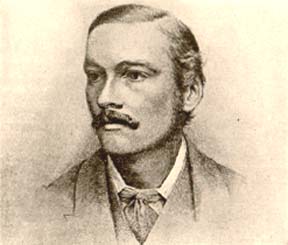- Francis Maitland Balfour
Infobox Scientist
name = PAGENAME
box_width =
image_size =150px
caption = PAGENAME
birth_date =November 10 ,1851
birth_place =Edinburgh
death_date =July 19 ,1882
death_place =Chamonix
residence = |citizenship =
nationality = British
ethnicity =
field =embryology
work_institutions =Trinity College, Cambridge
alma_mater =
doctoral_advisor =
doctoral_students =
known_for =
author_abbrev_bot =|author_abbrev_zoo =
influences =
influenced =
prizes =
religion = |footnotes = |Francis (Frank) Maitland Balfour, known as F. M. Balfour, (
November 10 ,1851 -July 19 ,1882 ) was a Britishbiologist [cite journal
quotes = yes
last=Hall
first=Brian K
authorlink=
year=2003|month=Oct.
title=Francis Maitland Balfour (1851-1882): a founder of evolutionary embryology
journal=J. Exp. Zool. B Mol. Dev. Evol.
volume=299
issue=1
pages=3-8
publisher= |location =United States | issn = 1552-5007| pmid = 14508811
doi = 10.1002/jez.b.35
bibcode = | oclc =| id = | url = | language = | format = | accessdate = | laysummary = | laysource = | laydate = | quote = ] . He lost his life while attempting the ascent ofMont Blanc . He was regarded by his colleagues as one of the greatest biologists of his day andCharles Darwin 's successor.Life
The younger brother of the politician,
Arthur Balfour , he was born atEdinburgh inScotland . He attendedHarrow School , where he showed no outstanding ability. However, one of the masters,George Griffith , encouraged and aided him in the pursuit of natural science, a taste for which, especiallygeology , he had acquired from his mother. EnteringTrinity College, Cambridge , in 1870, he was elected a natural science scholar of his college in the following year, and obtained second place in the Natural ScienceTripos of December 1873.Career
A course of lectures on
embryology , delivered by Sir Michael Foster in 1871, turned Balfour's attention toanimal morphology . After the tripos, he was selected to occupy one of the two seats allocated to theUniversity of Cambridge at theNaples zoological station. The research work which he began there contributed in an important degree to his election as a Fellow of Trinity in 1874; and also gave him the material for a series of papers (published as a monograph in 1878) on theElasmobranch fish, which threw new light on the development of several organs in theVertebrate s, in particular of the uro-genital and nervous systems.His next work was a large treatise, "Comparative Embryology", in two volumes; the first, published in 1880, dealing with the
Invertebrate s, and the second (1881) with theVertebrate s. This book displayed a vigorous scientific imagination, controlled by a logical sense that rigidly distinguished between fact and hypothesis, and it quickly won wide recognition, both as an admirable digest of the numberless observations made with regard to the development of animals during the quarter of a century preceding its publication, and as a work of original research.Balfour's reputation was now such that other universities became anxious to secure his services, and he was invited to succeed Professor
George Rolleston atOxford and SirWyville Thomson atEdinburgh . Although he was only a college lecturer, holding no official post in his university, he declined to leave Cambridge, and in the spring of 1882 the university instituted a special Chair of Animal Morphology for his benefit.Early death
He never delivered a lecture in his new position. In the first term after his appointment he was prevented from working by an attack of
typhoid fever . Going to theAlps for his health, he was killed, probably onJuly 19 1882 , attempting the ascent of theAiguille Blanche ,Mont Blanc , at that time unscaled. Besides being a brilliant morphologist, Balfour was an accomplished naturalist. Huxley thought he was "the only man who can carry out my work", and that the deaths of Balfour andW.K. Clifford were "the greatest loss to science in our time". [Huxley, Leonard 1900. "The Life and Letters of Thomas Henry Huxley". 2 vols 8vo, London: Macmillan. ] .He was a committed Darwinian, though he disagreed with Darwin on the origins of larvae. Darwin assumed that larvae arose from the same stock as adults, but Balfour believed that virtually all larvae are ‘secondary’, i.e. they “have become introduced into the ontogeny of species, the young of which were originally hatched with all the characters of the adult” ("Comparative Embyology", Vol 2, p300). In the case of echinoderms, he argued that the bilateral larvae must have been introduced after the establishment of the existing classes, and he challenged Haeckel’s view that these larvae are evidence that echinoderms evolved from bilateral ancestors.
References
External links
Wikimedia Foundation. 2010.
